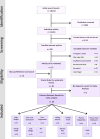The effect of high-sugar feeding on rodent metabolic phenotype: a systematic review and meta-analysis
- PMID: 40604308
- PMCID: PMC12118738
- DOI: 10.1038/s44324-024-00043-0
The effect of high-sugar feeding on rodent metabolic phenotype: a systematic review and meta-analysis
Abstract
Dietary sugar consumption has been linked to increased cardiometabolic disease risk, although it is unclear if this is independent of increases in body weight and adiposity. Additionally, many preclinical animal studies provide liquid sugar which more readily leads to excess consumption and weight gain, confounding any outcomes driven by high-sugar intake alone. To gain clarity on this, we conducted a systematic review and meta-analysis exclusively investigating the effect of isocaloric high-sugar, low-fat solid diet formulations containing fructose or sucrose, on cardiometabolic health in rodents. Overall, we found strong evidence that fructose and sucrose have effects on metabolic health, independent of body weight gain. High-sugar feeding, with fructose in particular, altered liver phenotype; ALT (d = 1.08; 0.66, 1.5), triglyceride content (d = 0.52; 0.25, 0.78), cholesterol (d = 0.59; 0.16, 1.03) and liver mass (d = 0.93; 0.37, 1.48), and glucose tolerance; fasting glucose (d = 0.60; 0.18, 1.01) and fasting insulin (d = 0.42; 0.07, 0.77) but not body weight or energy intake. Our review also highlights the lack of data reported on adiposity and in female rodents. This is the first meta-analysis to synthesise all current rodent solid diet high-sugar studies, while adjusting them for confounders (fat content, time spent on diet and age started on diet) and suggests that high-sugar dietary intake and composition alters metabolic health of mice regardless of weight gain.
© 2024. The Author(s).
Conflict of interest statement
Competing interests: The authors declare no competing interests.
Figures





Similar articles
-
Systemic pharmacological treatments for chronic plaque psoriasis: a network meta-analysis.Cochrane Database Syst Rev. 2021 Apr 19;4(4):CD011535. doi: 10.1002/14651858.CD011535.pub4. Cochrane Database Syst Rev. 2021. Update in: Cochrane Database Syst Rev. 2022 May 23;5:CD011535. doi: 10.1002/14651858.CD011535.pub5. PMID: 33871055 Free PMC article. Updated.
-
Antidepressants for pain management in adults with chronic pain: a network meta-analysis.Health Technol Assess. 2024 Oct;28(62):1-155. doi: 10.3310/MKRT2948. Health Technol Assess. 2024. PMID: 39367772 Free PMC article.
-
Systemic pharmacological treatments for chronic plaque psoriasis: a network meta-analysis.Cochrane Database Syst Rev. 2017 Dec 22;12(12):CD011535. doi: 10.1002/14651858.CD011535.pub2. Cochrane Database Syst Rev. 2017. Update in: Cochrane Database Syst Rev. 2020 Jan 9;1:CD011535. doi: 10.1002/14651858.CD011535.pub3. PMID: 29271481 Free PMC article. Updated.
-
Home treatment for mental health problems: a systematic review.Health Technol Assess. 2001;5(15):1-139. doi: 10.3310/hta5150. Health Technol Assess. 2001. PMID: 11532236
-
Interventions for preventing weight gain after smoking cessation.Cochrane Database Syst Rev. 2012 Jan 18;1:CD006219. doi: 10.1002/14651858.CD006219.pub3. Cochrane Database Syst Rev. 2012. Update in: Cochrane Database Syst Rev. 2021 Oct 6;10:CD006219. doi: 10.1002/14651858.CD006219.pub4. PMID: 22258966 Updated.
References
-
- Morris, M. J., Beilharz, J. E., Maniam, J., Reichelt, A. C. & Westbrook, R. F. Why is obesity such a problem in the 21st century? The intersection of palatable food, cues and reward pathways, stress, and cognition. Neurosci. Biobehav. Rev.58, 36–45 (2015). - PubMed
-
- Hariri, N. & Thibault, L. High-fat diet-induced obesity in animal models. Nutr. Res. Rev.23, 270–299 (2010). - PubMed
-
- Speakman, J. R. Use of high-fat diets to study rodent obesity as a model of human obesity. Int. J. Obes.43, 1491–1492 (2019). - PubMed
LinkOut - more resources
Full Text Sources
